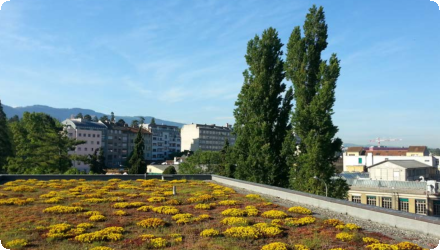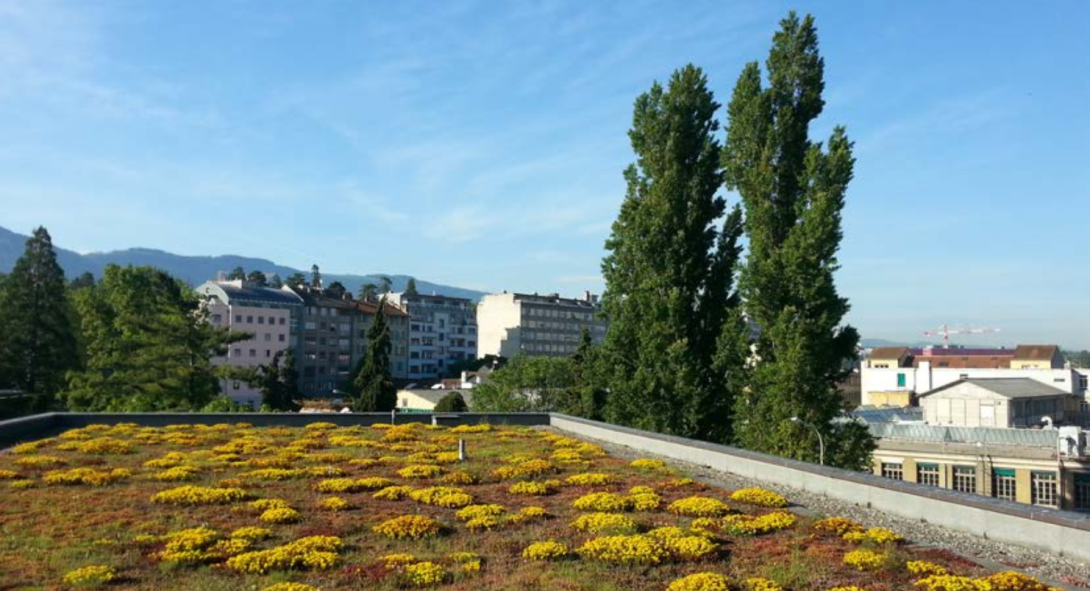Last update
2025
Summary
Located in Geneva, this case describes the long-running programme of green roofs at the University Hospitals of Geneva (HUG). The first roof (≈0.55 ha, 1993) was designed to retain ~30.25 m³/day; compared with a conventional roof it retains about 60% of runoff, while also recreating urban habitat. Since then the scheme has expanded: in 2023 HUG added 2,835 m² on three buildings (Maison de l’enfance et de l’adolescence, Adult Emergency extension, GIBOR). After a full inventory in 2024, HUG reports more than 11,900 m² of vegetated roofs across its sites.
Local monitoring in Geneva (TVEG/HEPIA) confirms hydrologic benefits beyond the original design assumptions: storm peaks are delayed and attenuated, with up to ~75% reduction for a summer event (and ~48% in winter), and a larger share of water returned by evapotranspiration (~61%) relative to a reference roof. The Canton’s “Nature en ville” programme documents biodiversity outcomes and provides up-to-date technical guidance; at cantonal level, compliant green roofs can lower stormwater fees.
Local monitoring in Geneva (TVEG/HEPIA) confirms hydrologic benefits beyond the original design assumptions: storm peaks are delayed and attenuated, with up to ~75% reduction for a summer event (and ~48% in winter), and a larger share of water returned by evapotranspiration (~61%) relative to a reference roof. The Canton’s “Nature en ville” programme documents biodiversity outcomes and provides up-to-date technical guidance; at cantonal level, compliant green roofs can lower stormwater fees.
Position
Latitude
46.2
Longitude
6.15
Project
NWRM
National Id
Switzerland_02
Installation date
1993-06
Implementation Status
Contact
Anais Hanus, ACTeon
RBD code
CH50
Transboundary
0
Photo gallery
Location of the project
On HUG’s Cluse-Roseraie campus, south of Geneva centre, between Rue Gabrielle-Perret-Gentil and Rue Alcide-Jentzer, on the large south-zone terraces above the hospital buildings.
NUTS Code
CH07 - Ticino
Project's objectives
• Vegetate ~5 500 m² (of 11 000 m² terrace)
• Retain about 30.25 m³/day; ~60 % of rainfall vs. traditional roof
• Recreate a biotope on a hospital terrace to improve microclimate/amenity.
• Retain about 30.25 m³/day; ~60 % of rainfall vs. traditional roof
• Recreate a biotope on a hospital terrace to improve microclimate/amenity.
Involved Partners
| Authority type | Authority name | Role | Comments |
|---|---|---|---|
Climate zone
cool temperate moist
Temperature
10,7
Precipitation
915
Annual rainfall range
900 - 1200 mm
Runoff
302
Runoff coefficient
0,33
Runoff range
450 - 600 mm
Evapotranspiration
1,5
Elevation range
398
Slope range
0.0
Vegetation class
Designed as mixed extensive + intensive green roofs: ~40–50 cm substrate with bulbs, herbaceous perennials, ferns, groundcovers; climbers on pergolas (trees limited by wind exposure). Recent additions include planters with trees, shrubs, perennials (Bio Suisse-labelled).
Water bodies: Ecological Status
Moderate
Water bodies: Chemical Status
Failing to achieve good
Water quality status
Urban Rhône/Arve face micropollutants (pesticides, drugs), storm overflows/urban runoff, and occasional accidental sewage discharges; biodiversity status locally flagged as mediocre in parts of the Rhône (2020 assessment).
Project scale
Micro
Project scale specification
A site-specific intervention on ~0.55 ha of hospital roofs, targeting on-parcel stormwater retention, thermal/amenity benefits and habitat at the building/campus level—not regional basin management.
Performance timescale
Immediate
Project area
0.55
Area subject to Land use change or Management/Practice change (ha)
0.55
Size
0.6
Size unit
m
Multifunctionality (runoff control + thermal + biodiversity + patient amenity). Layered build-up (inverted roof, drain layer, 40–50 cm substrate) with water guard in 10 cm drainage to retain rainfall and irrigate by capillarity; separate overflow to storm sewer.
Design capacity description
The measure was designed to retain about 30.25 m3/day.
Flat roof terraces with structural concrete deck; very wind-exposed, limiting tall trees; substrate depth enabled mixed planting; irrigation designed around local pluviometry with ~700 micro-sprinklers and a controlled water table in the drain layer; overflow to a separate storm network.
The existence of unexploited wide areas like roofs enable the implementation of the measure.
Total cost
CHF 5 million
Costs investment
4000000
Financing authorities
Type of funding
Local funds
Policy context
Initiated by the Canton (owner/client) as part of “on-parcel stormwater management” good practices; primary aim to recreate urban habitat and reduce runoff/heat and noise, improving patient and neighborhood amenity. Since 2020s, Geneva has pursued canton-wide promotion of green roofs (e.g., PL12778) and HUG’s 2030 sustainability strategy (green surfaces + heat-wave adaptation)
Land ownership
The south-zone roofs at HUG were built for (and by) the Republic and Canton of Geneva; maître d’ouvrage: the Canton. In 2020, only the north zone land transferred to HUG, south zone remains State-owned.
Community involvment
No
Design consultation activity
| Activity stage | Name | Key issues | Comments |
|---|
Policy target
| Target purpose |
|---|
|
Improved Biodiversity
|
|
Increase Water Storage
|
|
Oher Societal Benefits
|
Policy pressure
| Pressure directive | Relevant pressure |
|---|
Pressures remarks
The targeted problem is the runoff in urban areas, which increases flood risks.
Policy impact
| Impact directive | Relevant impact |
|---|
Requirement directive
| Requirement directive | Specification |
|---|
Contractual arrangements
0
| Arrangement type | Responsibility | Role | Name | Comments |
|---|
Part of wider plan
1
Wider plan type
| Wider plan type | Wider plan focus | Name | Comments |
|---|---|---|---|
|
National
|
Water
|
Federal law on water protection, 24 january 1991
|
|
|
Local
|
Water
|
Cantonal law on water (L 2 05)
|
Maintenance
The integration of invasive species management into roof maintenance contracts should help limit their spread.
Unknown
Green roofs improve the microclimate.
Green roofs provide vegetation in a urban area, from which - in this case - hospital patients can benefit from.
Hydrological effects
Evapotranspiration plays a significant role in reducing the urban rainwater management.
Retained water
30
Retained water unit
m3/day
Information on retained water
This number is theoretical; no performance evaluation has been done.
Increased water storage
60
Increased water storage unit
% Percent
Runoff reduction
60
Runoff reduction unit
% Percent
Water quality overall improvements
Not relevant for this application
Soil quality overall soil improvements
Not relevant for this application
1
Recreating habitat in urban areas.
Ecosystem impact climate regulation
No information available
Ecosystem provisioning services
0
Key lessons
The case study provides one example of how to implement and design green roofs. It has been shown that these rooftops are effective in limiting runoff compared to the intensity of rainfall received. Evapotranspiration accounts for a significant portion of the annual water balance. In winter, there is not enough time between rainfall events to evaporate all the water and restore maximum retention capacity, so the drain is used more frequently. In summer, the drain is rarely used.
Across 30 rooftops studied in Geneva, the average vascular plant cover (50%) falls short of the recommended 75%, but the significant presence of bryophytes (48%) partly compensates. Their presence is beneficial for biodiversity and should be preserved through appropriate management.
Across 30 rooftops studied in Geneva, the average vascular plant cover (50%) falls short of the recommended 75%, but the significant presence of bryophytes (48%) partly compensates. Their presence is beneficial for biodiversity and should be preserved through appropriate management.
Success factor(s)
| Success factor type | Success factor role | Comments | Order |
|---|---|---|---|
|
Attitude of relevant stakeholders
|
main factor
|
<p>The hospital, a private stakeholder, asked for implementing the measure. </p>
|
1
|
|
Financing possibilities
|
main factor
|
2
|
Driver
| Driver type | Driver role | Comments | Order |
|---|---|---|---|
|
Legal obligations
|
main driver
|
The federal law on water protection requests rain water infiltration in urban areas through retention measures.
|
1
|
|
Organisation committed to it
|
secondary driver
|
The Geneva Canton elaborated recommendations regarding water retention in urban areas
|
2
|
Transferability
Highly transferable to dense urban roofs with adequate load-bearing, waterproofing, safe maintenance access and wind protection. Pay attention to overflow design, substrate depth/species mix, irrigation needs, and integration with separate storm networks; follow local guides/standards.
English

